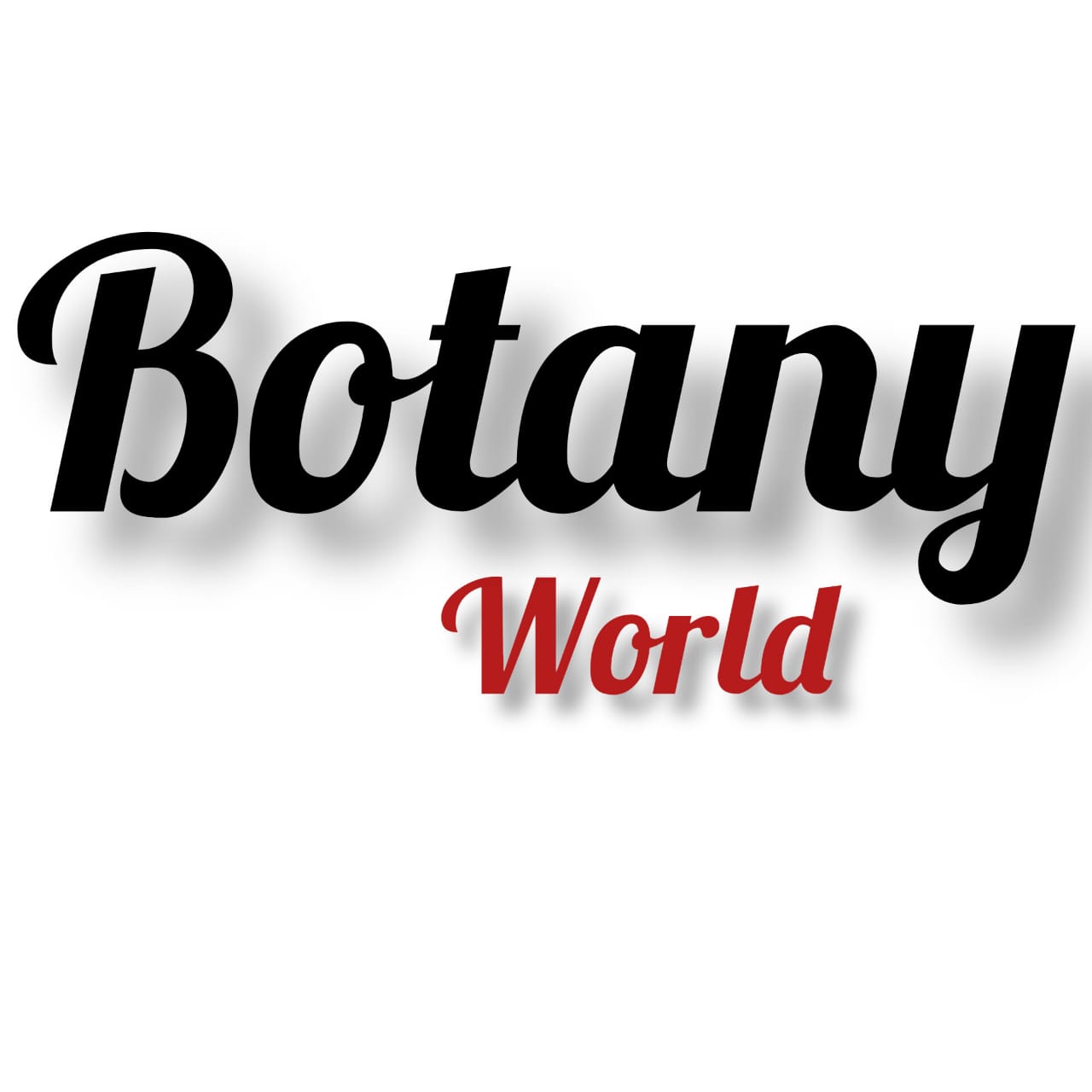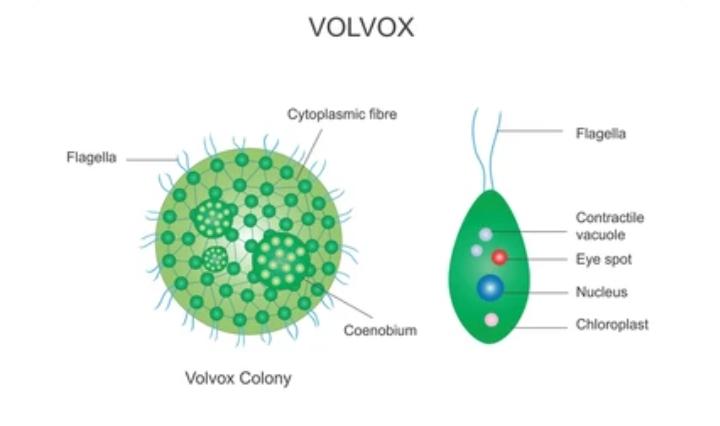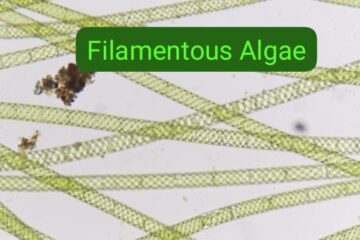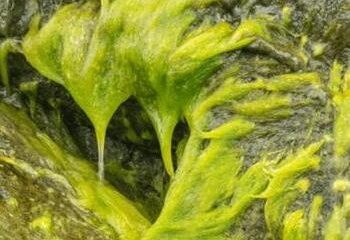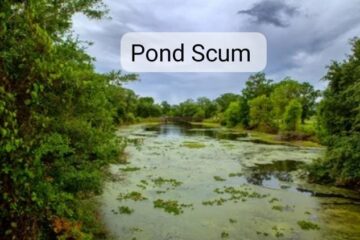Introduction
Volvox is a fascinating colonial organism belonging to the green algae family, known for its distinctive spherical shape and unique mode of movement. These microscopic organisms form colonies consisting of thousands of individual cells, each specialized for specific functions. Held together by a gelatinous matrix, the colony appears as a single-layered hollow ball. With the help of two flagella on some specialized cells, it can swim in a rolling motion through water. This green alga is photosynthetic, using chloroplasts and chlorophyll to convert light energy into food. it’s reproductive methods include both asexual and sexual reproduction. Found in freshwater habitats worldwide, it serves as an essential contributor to oxygen production and a food source for various aquatic organisms. Due to its simplicity and unique characteristics, it is an intriguing model organism in scientific research, providing valuable insights into multicellular life and biological processes.

Definition
It is a colonial, microscopic green alga found in freshwater habitats. It forms spherical colonies comprising numerous interconnected cells held together by a gelatinous matrix. It exhibits rolling movement through water using two flagella on specialized cells and is photosynthetic, converting light energy into food.
What is a Volvox?
In a simple and straightforward manner, it is a microscopic, colonial green alga. It forms spherical colonies made up of thousands of individual cells, held together by a gelatinous matrix. Each colony exhibits a unique mode of movement, rolling through water with the help of two flagella on some specialized cells. it is photosynthetic, using chlorophyll to convert light energy into food, and it reproduces both sexually and asexually. It is commonly found in freshwater habitats around the world and serves as an essential component of aquatic ecosystems.
Taxonomy and classification
It belongs to the domain Eukarya, kingdom Plantae (also considered as Protista), and division Chlorophyta (green algae). It is classified under the class Chlorophyceae and order Volvocales. The genus name is Volvox, and the species name can vary depending on the specific type, such as Volvox aureus or Volvox globator.
Morphology and structure
The morphology and structure of Volvox are fascinating and unique. Here’s an overview:
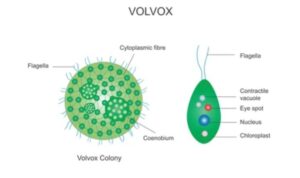
- Colony Shape: Its colonies are spherical in shape, resembling a hollow ball. The colonies can range in size from a few hundred micrometers to a few millimeters.
- Cell Arrangement: The spherical colony is composed of thousands of individual cells arranged in a single layer on the surface. These cells are interconnected and form a hollow interior.
- Gelatinous Matrix: The cells are embedded in a gelatinous matrix that holds the colony together, providing structural support and maintaining its shape.
- Cell Types: Within the colony, there are two main types of cells – somatic cells and reproductive cells. Somatic cells are responsible for carrying out various functions, while reproductive cells are involved in the formation of new colonies.
- Flagella: Some of the specialized somatic cells have two flagella, whip-like appendages used for movement. The coordinated beating of these flagella enables it to swim through water in a rolling motion.
- Chloroplasts: The cells of Volvox contain chloroplasts, which house chlorophyll, the green pigment responsible for capturing sunlight during photosynthesis.
- Cytoplasmic Bridges: The cells are connected to each other by fine cytoplasmic bridges, allowing the exchange of materials and communication within the colony.
- Daughter Colonies: As the colony grows and matures, daughter colonies develop within the parent colony. These daughter colonies eventually break free and disperse, starting new colonies.
The unique colonial structure of Volvox, along with its movement and reproductive strategies, makes it a captivating organism to study in the field of biology and offers valuable insights into the transition from unicellular to multicellular life forms.
Movement and locomotion
The movement and locomotion of Volvox are remarkable and quite fascinating. Despite being a colonial organism, it exhibits a form of coordinated movement that allows it to navigate through water. Here’s how it works:
- Rolling Motion: Volvox colonies move in a rolling motion through water. This motion resembles a somersault, where the colony rotates around its main axis as it swims.
- Flagella: The movement is made possible by the presence of two flagella on specialized somatic cells found on the surface of the colony. These flagella are whip-like appendages that extend outwards.
- Flagellar Coordination: The movement is achieved through the coordinated beating of the flagella. Flagella on the cells located at the front of the colony push the organism forward, while those at the back help maintain balance and direction.
- Fluid Drag: The rolling motion minimizes fluid drag as the colony moves through water, making it a more efficient way of locomotion compared to a linear swim.
- Phototaxis: Volvox exhibits phototaxis, a behavior where it moves towards or away from a light source. This behavior is influenced by the orientation of the colony relative to the light, allowing it to optimize its photosynthesis.
- Speed: it can move at a relatively slow pace, typically a few centimeters per hour, which is impressive considering its colonial nature.
The ability of it to move in a coordinated manner despite being a colonial organism is a remarkable adaptation. This rolling motion, along with its photosynthetic capabilities, allows Volvox to effectively navigate its aquatic environment, search for light and nutrients, and play a significant role in freshwater ecosystems.
Ecological role
It plays an essential ecological role in freshwater ecosystems. As a green alga with photosynthetic capabilities and a unique colonial structure, it contributes significantly to the ecosystem in the following ways:
- Oxygen Production: Through photosynthesis, it produces oxygen as a byproduct, contributing to the oxygen levels in the water. This is crucial for supporting aquatic life, including fish and other organisms that require oxygen for respiration.
- Carbon Fixation: It fixes carbon dioxide from the atmosphere and converts it into organic carbon compounds during photosynthesis. This helps in regulating carbon cycling in the ecosystem.
- Nutrient Cycling: As it grows and reproduces, it assimilates nutrients such as nitrogen and phosphorus from the water. When the colonies die and decompose, these nutrients are released back into the ecosystem, supporting the growth of other organisms.
- Food Source: Volvox serves as an essential food source for various aquatic organisms, including small invertebrates and zooplankton. It forms part of the base of the aquatic food chain and contributes to the overall biodiversity of the ecosystem.
- Habitat Structure: The presence of Volvox colonies provides habitat structure and shelter for small aquatic organisms, offering protection from predation and adverse environmental conditions.
- Bioremediation: In polluted water bodies, Volvox can help in bioremediation by absorbing and filtering out certain pollutants and contaminants, improving water quality.
- Competition and Balance: Volvox competes with other algae and phytoplankton for resources, contributing to the ecological balance in the ecosystem. Its presence may influence the abundance and distribution of other species.
- Trophic Interactions: The consumption of Volvox by herbivores and other organisms creates trophic interactions and energy transfer within the food web, affecting the overall ecosystem dynamics.
Overall, it’s photosynthetic abilities, nutrient cycling, and position in the food web make it an ecologically significant organism in freshwater ecosystems. Its interactions with other organisms and its role in maintaining a balanced and functioning ecosystem highlight its importance in the intricate web of life in aquatic habitats.
Types
Volvox is a genus of green algae, and within this genus, there are several different species. Some of the common types or species of Volvox include:
- Volvox aureus: This species is one of the most well-known and widely studied types of Volvox. It forms large spherical colonies and is often used as a model organism in scientific research.
- Volvox globator: This species is known for its distinctive rolling motion and is commonly found in freshwater ponds and lakes.
- Volvox carteri: Another commonly studied species, Volvox carteri, has been extensively used in research to understand various biological processes, including sexual reproduction and development.
- Volvox barberi: This species is found in various freshwater habitats and shares many characteristics with other types of Volvox.
- Volvox tertius: A smaller species of Volvox with colonies that typically consist of around 100-200 cells.
It’s important to note that the taxonomy and classification of Volvox may continue to evolve as scientific research and knowledge progress. Different species of Volvox may be identified, and further studies may provide more insights into their diversity and ecological significance.
Life cycle
The life cycle of Volvox involves both sexual and asexual reproduction, contributing to its unique colonial structure and perpetuation of its species. Here’s a simplified overview of the life cycle:
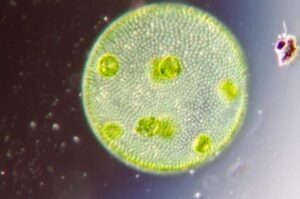
-
Asexual Reproduction:
- A mature Volvox colony undergoes a process called vegetative asexual reproduction.
- Within the colony, specialized cells called gonidia divide rapidly through multiple rounds of cell division.
- This asexual division results in the growth of daughter colonies within the parent colony.
- As the daughter colonies grow and mature, they become fully functional and self-sustaining.
-
Sexual Reproduction:
- Under specific environmental conditions, usually due to a decrease in nutrients or other factors, Volvox undergoes sexual reproduction to increase genetic diversity.
- Some somatic cells within the colony differentiate into specialized reproductive cells called gametes.
- Female gametes (eggs) are larger and non-motile, while male gametes (sperm packets) are smaller and motile.
- The male gametes are released into the surrounding water, where they swim to find and fuse with female gametes.
- Upon fusion, the zygote is formed.
-
Zygote Development:
- The zygote is a dormant and resistant stage, protected by a thick, protective wall.
- The zygote undergoes a period of dormancy, allowing it to survive harsh conditions.
- When favorable conditions return, the zygote undergoes meiosis, resulting in the formation of new haploid cells.
- These new cells divide and grow to form a new multicellular Volvox colony, starting the cycle a new.
The life cycle of Volvox involves a balance between asexual reproduction, which allows for rapid population growth, and sexual reproduction, which promotes genetic diversity and adaptability. This life cycle contributes to the success and survival of Volvox in a variety of freshwater environments.
Evolutionary significance
The evolutionary significance of Volvox lies in its unique transition from unicellular to multicellular life. Volvox belongs to the green algae family, and its colonial structure represents an important step in the evolution of complex multicellular organisms. Some key evolutionary aspects of Volvox include:
- Emergence of Multicellularity: Volvox demonstrates how unicellular organisms can evolve into multicellular forms. The cells within the colony work together, forming a cooperative and integrated unit, which is essential for survival and reproduction.
- Division of Labor: Within the Volvox colony, individual cells specialize for different functions. Some cells are involved in locomotion, while others perform reproductive or photosynthetic roles. This division of labor is a significant evolutionary step toward the development of specialized tissues and organs found in more complex multicellular organisms.
- Communication and Cooperation: The cells in a Volvox colony communicate and coordinate their movements to achieve a rolling motion. This communication and cooperation are crucial evolutionary adaptations that underlie the evolution of complex social behaviors and cooperation observed in higher organisms.
- Genetic Complexity: The development of multicellularity in Volvox required genetic changes to regulate cell differentiation, division, and coordination. Studying the genetic mechanisms involved in Volvox’s development can shed light on the evolutionary steps that paved the way for the genetic complexity seen in more advanced multicellular organisms.
- Reproductive Strategies: Volvox demonstrates both asexual and sexual reproduction. The evolution of sexual reproduction introduced genetic recombination and increased genetic diversity, providing a selective advantage and contributing to the evolutionary success of multicellular organisms.
- Transitional Organism: Volvox serves as an excellent model for understanding the transition from unicellular to multicellular life forms. Its relatively simple structure bridges the gap between unicellular green algae and more complex multicellular organisms, making it an important evolutionary link.
Studying Volvox and its evolutionary history can provide valuable insights into the processes and mechanisms that led to the diversification and complexity of life on Earth. It offers a unique opportunity to explore the early stages of multicellular evolution and the key adaptations that have shaped the development of life’s diverse forms.
Environmental impacts
Volvox, as a part of freshwater ecosystems, can have both positive and negative environmental impacts:
Positive Environmental Impacts:
- Oxygen Production: Volvox contributes to oxygen production through photosynthesis. This oxygen is vital for supporting aquatic life, including fish and other organisms that rely on oxygen for respiration.
- Nutrient Cycling: Volvox plays a role in nutrient cycling by assimilating nutrients from the water and releasing them back into the ecosystem when the colonies die and decompose. This helps in maintaining nutrient balance and supporting the growth of other organisms.
- Food Source: Volvox serves as an essential food source for various aquatic organisms, including small invertebrates and zooplankton. It forms part of the base of the aquatic food chain, supporting higher trophic levels.
- Bioremediation: In polluted water bodies, Volvox can help in bioremediation by absorbing and filtering out certain pollutants and contaminants, thereby improving water quality.
Negative Environmental Impacts:
- Algal Blooms: Under certain conditions, Volvox colonies can undergo rapid growth, leading to algal blooms. Large algal blooms can disrupt the balance of the ecosystem and negatively impact water quality by depleting oxygen and blocking sunlight from reaching other aquatic plants.
- Competition with Native Species: In some cases, invasive species of Volvox can outcompete native aquatic plants and algae, disrupting the natural balance of the ecosystem.
- Water Discoloration: When algal blooms occur, the large number of Volvox colonies can cause the water to become greenish or turbid, reducing visibility and potentially affecting the feeding and navigation of other organisms.
It’s important to note that the environmental impacts of Volvox can vary depending on factors such as the species of Volvox, environmental conditions, and overall ecosystem health. While Volvox can have beneficial effects on nutrient cycling and food webs, excessive growth can lead to ecological imbalances and water quality issues. To manage and maintain healthy freshwater ecosystems, it’s essential to monitor and understand the dynamics of Volvox populations and their interactions with other organisms in the ecosystem.
Biotechnological applications
As of my last update in September 2021, Volvox and related organisms have shown potential in various biotechnological applications. Some of these applications include:
- Biofuel Production: Volvox is photosynthetic and can efficiently convert light energy into biomass. Researchers are exploring the use of Volvox as a source of biofuels, such as biodiesel or bioethanol, by harnessing its ability to produce organic matter.
- Bioremediation: Volvox, along with other algae, has the capability to absorb and remove certain pollutants from water, such as heavy metals and organic contaminants. This ability makes it a potential candidate for bioremediation of polluted water bodies.
- Environmental Monitoring: Volvox can serve as a bio indicator for water quality. Changes in Volvox population dynamics can signal environmental changes, such as pollution or changes in nutrient levels, which can help in monitoring the health of aquatic ecosystems.
- Pharmaceutical and Biomedical Research: Volvox has been used as a model organism in pharmaceutical and biomedical research. Its colonial structure and differentiation of cells provide insights into cell communication, differentiation, and development, which can have implications for understanding human diseases and tissue engineering.
- Nanotechnology: Researchers are exploring the use of Volvox and other microorganisms in nanotechnology applications. For instance, Volvox-based nanomaterials could be utilized in drug delivery systems or in the development of biosensors.
- Genetic Studies: Volvox has a relatively simple genome, making it an attractive model organism for genetic studies. Understanding the genetics of Volvox can help shed light on fundamental biological processes and evolutionary relationships.
It’s worth mentioning that biotechnological research is continuously evolving, and new applications of Volvox and other microorganisms are being explored. The potential of Volvox in biotechnology highlights the importance of studying and understanding these unique organisms for various practical and scientific purposes. However, the implementation of biotechnological applications requires careful consideration of ethical and environmental implications.

Conclusion
In conclusion, Volvox is a remarkable and unique organism within the green algae family. Its colonial structure, with thousands of individual cells forming a spherical colony, allows for coordinated movement and efficient navigation through water. With photosynthetic capabilities, Volvox plays a crucial role in oxygen production, nutrient cycling, and supporting aquatic food webs. Its life cycle, involving both asexual and sexual reproduction, contributes to its adaptability and success in freshwater ecosystems. It’s significance extends beyond its ecological role, as it serves as a valuable model organism in scientific research, with potential applications in biotechnology and nanotechnology. Understanding Volvox and its ecological and biological aspects provides valuable insights into the complexity and diversity of life on Earth. Continued study and appreciation of this fascinating organism offer opportunities for further scientific discoveries and innovations in various fields.
Question / Answers
- Question: What is the main characteristic that defines Volvox’s colonial structure?
Answer: The main characteristic that defines Volvox’s colonial structure is its spherical shape, with individual cells arranged in a single layer on the surface, forming a hollow interior.
- Question: How does Volvox achieve movement through water?
Answer: Volvox achieves movement through a rolling motion, using two whip-like flagella on specialized somatic cells. The coordinated beating of these flagella enables the organism to swim in a somersault-like manner.
- Question: What is the primary role of Volvox in freshwater ecosystems?
Answer: The primary role of Volvox in freshwater ecosystems is oxygen production through photosynthesis. It also contributes to nutrient cycling and serves as a food source for various aquatic organisms.
- Question: What are the two main modes of reproduction in Volvox?
Answer: Volvox reproduces through both asexual and sexual reproduction. Asexual reproduction involves vegetative cell division, while sexual reproduction involves the formation of male and female gametes.
- Question: How does Volvox contribute to bioremediation in polluted water bodies?
Answer: Volvox absorbs and filters out certain pollutants and contaminants from the water, which helps improve water quality and aids in the bioremediation process.
- Question: In what ways is Volvox used as a model organism in scientific research?
Answer: Volvox is used as a model organism to study various biological processes, such as sexual reproduction, development, and cell communication. Its simple multicellular structure makes it a valuable subject for genetic and evolutionary studies.
- Question: What are some potential biotechnological applications of Volvox?
Answer: Volvox has potential applications in biofuel production, bioremediation, environmental monitoring, nanotechnology, and biomedical research, due to its photosynthetic capabilities and unique biological characteristics.
- Question: How does Volvox exhibit phototaxis, and why is this behavior significant?
Answer: Volvox exhibits phototaxis by moving towards or away from a light source, optimizing its photosynthesis. This behavior is significant as it allows Volvox to efficiently position itself to capture light and nutrients, enhancing its survival and growth in its aquatic habitat.
- Question: Describe the life cycle of Volvox, highlighting the two reproductive processes involved.
Answer: The life cycle of Volvox involves both asexual and sexual reproduction. Asexual reproduction leads to the growth of daughter colonies within the parent colony, while sexual reproduction involves the formation of male and female gametes, leading to the development of zygotes.
- Question: How does the presence of Volvox colonies impact water quality in lakes and ponds?
Answer: While Volvox contributes positively to nutrient cycling and oxygen production, excessive growth of Volvox colonies can lead to algal blooms, affecting water quality by depleting oxygen and blocking sunlight, potentially disrupting the balance of the ecosystem.
